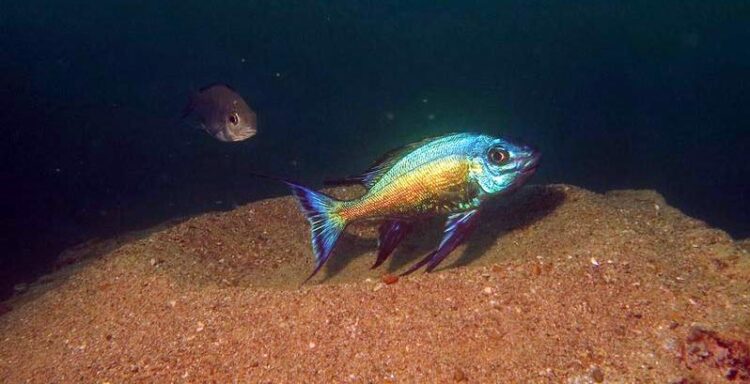Highly dynamic sex chromosomes in cichlid fishes

In many cichlids in Lake Tanganyika, the difference between females and males is clearly visible externally, as here in Cyathopharynx foae (female left, male right).
(c) Adrian Indermaur / Zoology/University of Basel
The cichlids of Lake Tanganyika in Africa are highly diverse – including with regard to sex chromosomes. These have changed extremely frequently in the course of the evolution of these fish and, depending on the species, can be of the type XY or ZW. This has been reported by a research team from the University of Basel and the Research Museum Koenig in Bonn in the scientific journal Science Advances.
Based on the biology lessons back in our schooldays, we know that XX means female, and XY means male. In mammals, these constellations of sex chromosomes determine whether an individual becomes a female or a male. It is different in birds, where the principle of ZW = female, ZZ = male applies. In many reptiles, the temperature at which the eggs develop determines the sex. The way in which genetic sex is determined can therefore vary from species to species, with different sex-determining systems having occurred during evolution. In fish, the most biodiverse group of vertebrates, we find different genetic systems (including the XY and ZW types of mammals and birds, respectively) as well as environmental systems (as in many reptiles).
The evolution of sex chromosomes
Sex chromosomes are derived from « normal » chromosomes – the autosomes – after acquiring a new, sex-determining mutation. The resulting new chromosome pair takes separate paths in the course of evolution, ensuring that there is no exchange of sex-determining genes between the two sex chromosomes.
In mammals, this process took place around 165 million years ago, and resulted in the XY system with a male-specific Y chromosome. In birds, the W is a female-specific chromosome. In fish, on the other hand, it has been known for some time that there is no general sex chromosome system.
With the aid of next-generation genome sequencing methods that allow for a comparison between the genomes of both sexes, a new world of sex chromosomes has been identified in fish: During their evolution, different chromosomes have developed independently of each other in different fish lineages as sex chromosomes. Yet, the repeated appearance of similar or functionally related sex-determining genes suggests that there is a pool of chromosome candidates that are particularly suitable for sex determination.
Cichlids are especially diverse
A research team at the Department of Environmental Sciences at the University of Basel led by Dr. Astrid Böhne (now at the Research Museum Koenig in Bonn) has now investigated the evolution of sex chromosomes in a highly diverse group of fish, the cichlids from Lake Tanganyika in Africa. A particular feature of these fish is that they are a prime example of adaptive radiation, a process in which a large number of species emerge in a relatively short time through rapid adaptation to various habitats.
The researchers analyzed extensive genome and transcriptome data of around 240 cichlid species for differences between females and males, which enabled them to identify sex chromosomes in over 70 species. Interestingly, substantial differences between the species became apparent with regard to the chromosomes responsible for sex determination. The course of the evolution of cichlids in Lake Tanganyika also saw several changes from sex chromosomes of type XY to ZW and vice versa.
«This means that these cichlids hold the record for transitioning between sex chromosomes in vertebrates,» says Astrid Böhne. At the same time, the Basel zoologists found out that certain chromosomes become sex chromosomes particularly often. This supports the hypothesis that there is a group of genes or even whole chromosomes that are particularly suitable for determining genetic sex.
Wissenschaftliche Ansprechpartner:
Dr. Astrid Böhne, Universität Basel, Fachbereich Zoologie, Departement Umweltwissenschaften, Tel. +49 228 9122 365, E-Mail: a.boehne@leibniz-zfmk.de
Prof. Dr. Walter Salzburger, Universität Basel, Fachbereich Zoologie, Departement Umweltwissenschaften, Tel. +41 61 207 03 03, E-Mail: walter.salzburger@unibas.ch
Originalpublikation:
Athimed El Taher, Fabrizia Ronco, Michael Matschiner, Walter Salzburger and Astrid Böhne, Dynamics of sex chromosome evolution in a rapid radiation of cichlid fishes , Science Advances (2021)
Media Contact
All latest news from the category: Life Sciences and Chemistry
Articles and reports from the Life Sciences and chemistry area deal with applied and basic research into modern biology, chemistry and human medicine.
Valuable information can be found on a range of life sciences fields including bacteriology, biochemistry, bionics, bioinformatics, biophysics, biotechnology, genetics, geobotany, human biology, marine biology, microbiology, molecular biology, cellular biology, zoology, bioinorganic chemistry, microchemistry and environmental chemistry.
Newest articles

Bringing bio-inspired robots to life
Nebraska researcher Eric Markvicka gets NSF CAREER Award to pursue manufacture of novel materials for soft robotics and stretchable electronics. Engineers are increasingly eager to develop robots that mimic the…

Bella moths use poison to attract mates
Scientists are closer to finding out how. Pyrrolizidine alkaloids are as bitter and toxic as they are hard to pronounce. They’re produced by several different types of plants and are…

AI tool creates ‘synthetic’ images of cells
…for enhanced microscopy analysis. Observing individual cells through microscopes can reveal a range of important cell biological phenomena that frequently play a role in human diseases, but the process of…





















